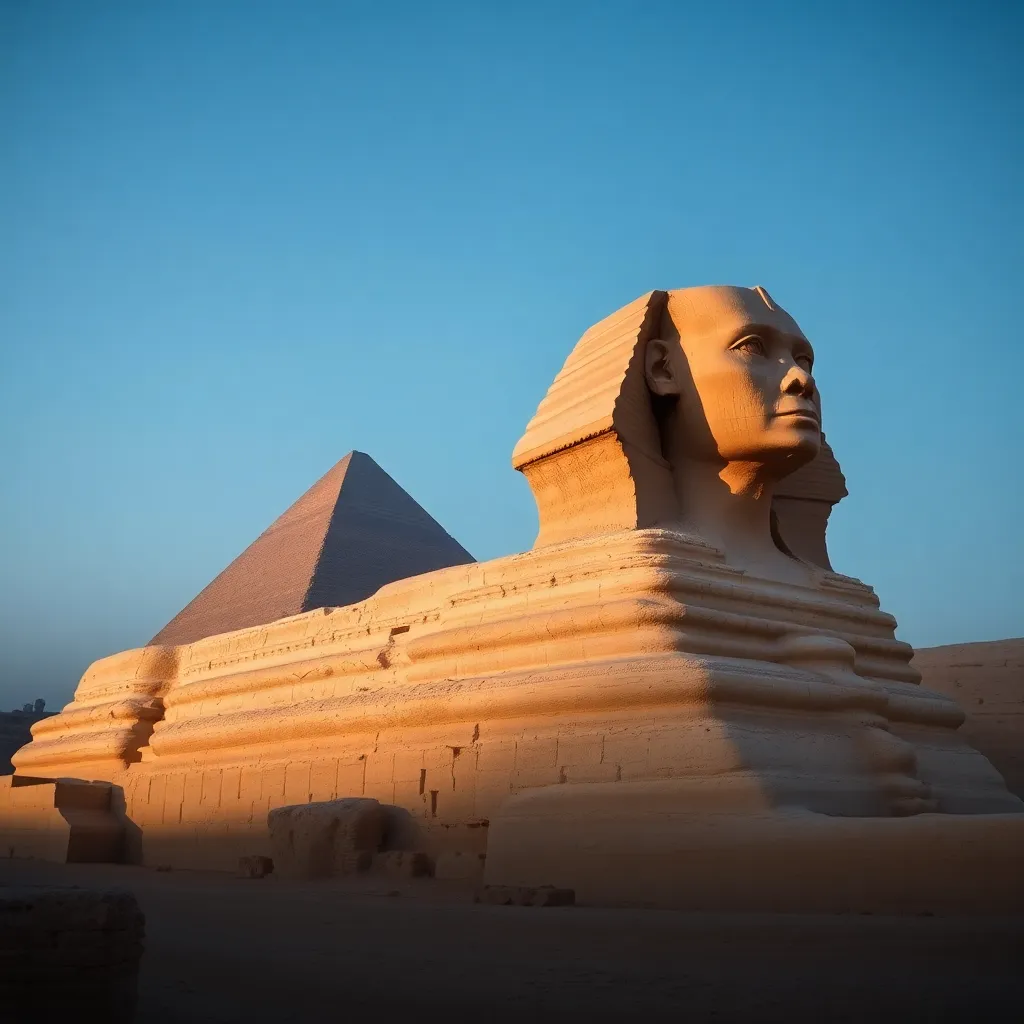The Great Sphinx of Giza: Myths Surrounding Its Creation
I. Introduction
The Great Sphinx of Giza, with its awe-inspiring visage and enigmatic presence, stands as one of the most iconic monuments of ancient Egypt. This limestone statue, which features a lion’s body and a human head, is located on the Giza Plateau, near the Great Pyramids. Its grandeur and sheer scale have captivated historians, archaeologists, and tourists for centuries.
The importance of the Sphinx in Egyptian culture and history cannot be overstated. It is seen as a guardian of the Giza Plateau, representing strength and wisdom. Moreover, the Sphinx embodies the cultural fusion of lion and human, signifying the power of pharaohs who were considered divine rulers in ancient Egyptian society.
This article aims to explore the various myths surrounding the creation of the Great Sphinx, delving into its historical context, the lore associated with its builder, and the modern interpretations that continue to shape our understanding of this ancient marvel.
II. Historical Context of the Sphinx
The Sphinx is strategically located between the Nile River and the desert, serving as a sentinel to the pharaohs’ tombs. Its proximity to the Pyramids of Giza indicates its significance as part of the funerary complex. Ancient Egyptians believed that the Sphinx played a vital role in the afterlife journey of the pharaohs.
Historical accounts suggest that the Sphinx was constructed during the reign of Pharaoh Khafre, around 2500 BCE. It is often depicted as a guardian of the pyramids and is believed to symbolize the pharaoh’s might. Archaeological findings, including inscriptions and remnants of ancient structures, have provided evidence supporting the Sphinx’s connection to Khafre.
- Inscriptions found on nearby temples link Khafre directly to the Sphinx.
- Archaeological excavations have unearthed tools and remnants that suggest a sophisticated understanding of engineering among the ancient Egyptians.
III. The Myth of Khafre’s Construction
The association of the Great Sphinx with Pharaoh Khafre is one of the most enduring myths in Egyptology. Many believe that Khafre commissioned the Sphinx as a representation of himself, merging his likeness with the powerful form of a lion.
Evidence supporting this myth includes:
- The proximity of the Sphinx to Khafre’s pyramid.
- Artistic representations of Khafre that resemble the features of the Sphinx.
However, alternative theories regarding the Sphinx’s builder have emerged over the years. Some scholars suggest that the Sphinx could have been constructed earlier than Khafre’s reign, possibly during the Fourth Dynasty under a different pharaoh. This theory is supported by geological studies indicating that erosion patterns on the Sphinx suggest a much older date of creation.
IV. Theories of Alien Involvement
One of the more sensational myths surrounding the Great Sphinx involves the ancient astronaut theory, which posits that extraterrestrials played a role in its construction. Proponents of this theory argue that the advanced architectural techniques displayed in the Sphinx could not have been achieved by ancient Egyptians alone.
Key arguments for and against alien involvement include:
- For: The precision of the Sphinx’s construction and alignment with celestial bodies is cited as evidence of advanced knowledge.
- Against: Many experts argue that ancient Egyptians had the necessary skills and tools to construct the Sphinx, as evidenced by other monumental structures of the time.
This myth has had a significant impact on popular culture, inspiring numerous documentaries, books, and films that explore the idea of ancient aliens influencing human civilization.
V. The Sphinx as a Symbol of Divine Power
Various theories suggest that the Sphinx was not merely a tomb guardian but a representation of divine power. In ancient Egyptian mythology, the lion is often associated with several deities, including Sekhmet and Maahes.
The religious and spiritual significance of the Sphinx can be analyzed through its possible connection to the sun god Ra. It is theorized that the Sphinx was a solar symbol, embodying the pharaoh’s divine connection to the gods. Myths suggest that the Sphinx may have been intended to protect the pharaoh’s soul and ensure safe passage to the afterlife.
VI. The Role of Erosion and Time in Myths
Natural erosion has played a crucial role in shaping the appearance of the Sphinx over the millennia. Wind and sand have worn down its features, leading to speculation about its age and origins.
Some myths suggest a connection between the Sphinx’s erosion and the Great Flood described in various ancient texts. This connection has fueled debates about the true timeline of the Sphinx’s construction and its link to other ancient myths.
The erosion of the Sphinx has also led to various theories about its origins, with some suggesting that it could be remnants of a lost civilization preceding the Egyptians. This adds another layer of mystery to the Sphinx’s already enigmatic history.
VII. Modern Interpretations and Cultural Impact
In contemporary society, the Great Sphinx continues to evoke intrigue and wonder. It is viewed not only as a historical monument but also as a symbol of mystery and the exploration of human civilization’s past.
The representation of the Sphinx in art, literature, and media has been profound. From modern films to literature, the Sphinx often symbolizes riddles, challenges, and the quest for knowledge. Its image is frequently used as a motif for wisdom and enigma.
Moreover, the Sphinx has become a symbol in modern mythology, inspiring various interpretations and adaptations that reflect contemporary values and ideas about history and civilization.
VIII. Conclusion
In summary, the myths surrounding the creation of the Great Sphinx of Giza are as varied as they are fascinating. From its association with Pharaoh Khafre to theories of alien involvement and divine representation, these myths provide insight into the values and beliefs of ancient Egyptian culture.
Understanding these myths is essential for appreciating the Sphinx’s significance in ancient Egypt and its lasting impact on modern society. As an enduring symbol of mystery, the Great Sphinx of Giza continues to inspire curiosity and speculation, ensuring its place in the annals of history for generations to come.




